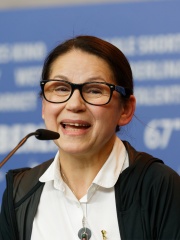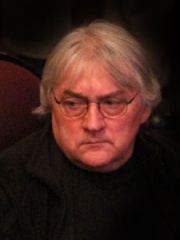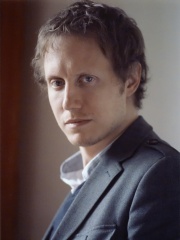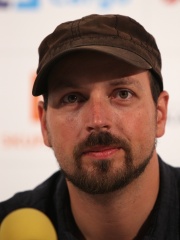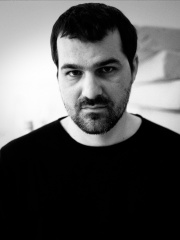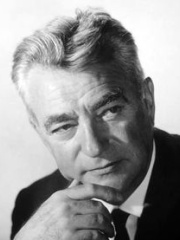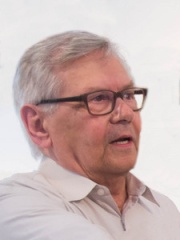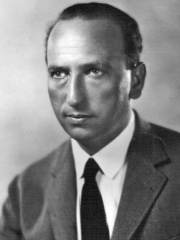
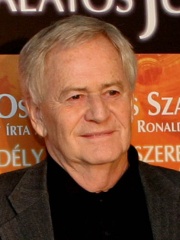
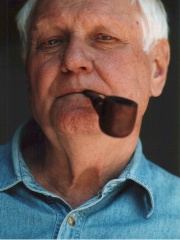
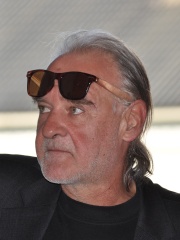

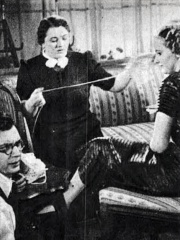
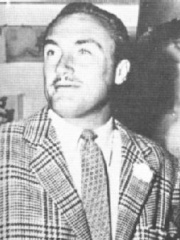

The Most Famous
FILM DIRECTORS from Hungary
This page contains a list of the greatest Hungarian Film Directors. The pantheon dataset contains 2,041 Film Directors, 30 of which were born in Hungary. This makes Hungary the birth place of the 13th most number of Film Directors behind Poland, and Canada.
Top 10
The following people are considered by Pantheon to be the top 10 most legendary Hungarian Film Directors of all time. This list of famous Hungarian Film Directors is sorted by HPI (Historical Popularity Index), a metric that aggregates information on a biography's online popularity. Visit the rankings page to view the entire list of Hungarian Film Directors.

1. Michael Curtiz (1886 - 1962)
With an HPI of 70.06, Michael Curtiz is the most famous Hungarian Film Director. His biography has been translated into 49 different languages on wikipedia.
Michael Curtiz (; born Manó Kaminer; from 1905 Mihály Kertész; Hungarian: Kertész Mihály; December 24, 1886 – April 10, 1962) was a Hungarian-American film director, recognized as one of the most prolific directors in history. He directed classic films from the silent era and numerous others during Hollywood's Golden Age, when the studio system was prevalent. Curtiz was already a well-known director in Europe when Warner Bros. invited him to Hollywood in 1926, when he was 39 years of age. He had already directed 64 films in Europe, and soon helped Warner Bros. become the fastest-growing movie studio. He directed 102 films during his Hollywood career, mostly at Warners, where he directed ten actors to Oscar nominations. James Cagney and Joan Crawford won their only Academy Awards under Curtiz's direction. He put Doris Day and John Garfield on screen for the first time, and he made stars of Errol Flynn, Olivia de Havilland, and Bette Davis. He himself was nominated five times, and won twice, once for Best Short Subject for Sons of Liberty and once as Best Director for Casablanca. Curtiz was among those who introduced to Hollywood a visual style using artistic lighting, extensive and fluid camera movement, high crane shots, and unusual camera angles. He was versatile, and could handle any film genre: melodrama, comedy, love story, film noir, musical, war story, Western, horror, or historical epic. He always paid attention to the human-interest aspect of every story, stating that the "human and fundamental problems of real people" were the basis of all good drama. The death of 25 horses in The Charge of the Light Brigade under Curtiz's direction resulted in a near-violent confrontation between Curtiz and star Errol Flynn, which led in turn to the U.S. Congress and the ASPCA enacting legislation and policy to prevent cruelty to animals on the sets of movies. Curtiz helped popularize the classic swashbuckler, with films such as Captain Blood (1935) and The Adventures of Robin Hood (1938), both starring Flynn. He directed many other dramas which are considered classics: Angels with Dirty Faces (1938), The Sea Wolf (1941), Casablanca (1942), and Mildred Pierce (1945). He directed leading musicals, including Yankee Doodle Dandy (1942), This Is the Army (1943), and White Christmas (1954), and he made comedies, with Life with Father (1947) and We're No Angels (1955).

2. István Szabó (b. 1938)
With an HPI of 68.11, István Szabó is the 2nd most famous Hungarian Film Director. His biography has been translated into 34 different languages.
István Szabó (Hungarian: [ˈsɒboː ˈiʃtvaːn]; born 18 February 1938) is a Hungarian film director, screenwriter, and opera director. Szabó is one of the most notable Hungarian filmmakers and one who has been best known outside the Hungarian-speaking world since the late 1960s. Working in the tradition of European auteurism, he has made films that represent many of the political and psychological conflicts of Central Europe's recent history, as well as of his own personal history. He made his first short film in 1959 as a student at the Academy of Drama and Film in Budapest, and his first feature film in 1964. He achieved his greatest international success with Mephisto (1981) for which he was awarded an Academy Award for Best Foreign Language Film. Since then, most of Szabó's films have been international co-productions filmed in a variety of languages and European locations. However, he has continued to make films in Hungarian, and even in his international co-productions he has often filmed in Hungary using Hungarian talent. In 2006, weekly Hungarian magazine Élet és Irodalom (Life and Literature in English) published an article revealing that Szabó had been an informant of the Communist regime's secret police.

3. Miklós Jancsó (1921 - 2014)
With an HPI of 66.90, Miklós Jancsó is the 3rd most famous Hungarian Film Director. His biography has been translated into 40 different languages.
Miklós Jancsó (Hungarian: [ˈmikloːʃ ˈjɒnt͡ʃoː]; 27 September 1921 – 31 January 2014) was a Hungarian film director and screenwriter. Jancsó achieved international prominence starting in the mid-1960s with works including The Round-Up (Szegénylegények, 1965), The Red and the White (Csillagosok, katonák, 1967), and Red Psalm (Még kér a nép, 1971). Jancsó's films are characterized by long takes, and their plot often takes place in historical periods and at rural settings. A frequent theme of his films is the abuse of power. His works are often allegorical commentaries on Hungary under Communism and the Soviet occupation, although some critics prefer to stress the universal dimensions of Jancsó's explorations. Towards the end of the 1960s and especially into the 1970s, Jancsó's work became increasingly stylized and overtly symbolic.

4. Béla Tarr (1955 - 2026)
With an HPI of 65.51, Béla Tarr is the 4th most famous Hungarian Film Director. His biography has been translated into 39 different languages.
Béla Tarr (21 July 1955 – 6 January 2026) was a Hungarian filmmaker. His films are distinguished by languid pacing, stark black-and-white visuals, extended long takes, and an absence of traditional plotting. They explore existential themes and often focus on marginalized, desperate characters in bleak landscapes. He became known as a founding figure of the slow cinema genre, most notably with his influential 1994 film Sátántangó. That film is often in scholarly polls of the greatest films ever made. Debuting with the film Family Nest (1979), Tarr began his directorial career with a brief period of what he refers to as "social cinema", aimed at telling everyday stories about ordinary people, often in the style of cinema vérité. Almanac of Fall (1984) follows the inhabitants of a run-down apartment as they struggle to live together while sharing their hostilities. The drama Damnation (1988) was lauded for its languid and controlled camera movement, which Tarr would become known for internationally. Sátántangó (1994) and Werckmeister Harmonies (2000) continued his bleak and desolate representations of reality, while incorporating apocalyptic overtones. Tarr would later compete at the 2007 Cannes Film Festival with his film The Man from London, which opened to moderately positive reviews. After the release of the critically acclaimed The Turin Horse (2011), Tarr announced his retirement from feature-length film direction. In February 2012 he moved to Sarajevo and in 2013 started an international film school known as film.factory, and lived between Budapest and Sarajevo thereafter. Lauded as one of the most exciting film schools in the world, it has practiced an unconventional and open study format with renowned international film artists as teachers. In his last decades, he continued to explore media beyond traditional film form. In 2017, at Eye Filmmuseum in Amsterdam, he developed an exhibition entitled Till the End of the World - a cross between a film, a theatre set, and an installation, which attracted over 40,000 visitors. Commissioned by the Wiener Festwochen, in 2019, he authored Missing People, a site-specific project created at the intersection between performance, installation, and motion picture, involving 250 Viennese homeless people. Director and editor Ágnes Hranitzky was Tarr’s partner in life and work (film editor and co-director) since they met in 1978 until 2012. Besides her, Tarr also collaborated with Nobel Prize-winning novelist László Krasznahorkai, film composer Mihály Víg, cinematographer Fred Kelemen, and actress Erika Bók.
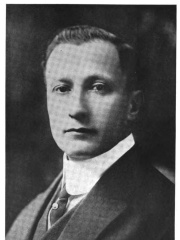
5. Adolph Zukor (1873 - 1976)
With an HPI of 64.49, Adolph Zukor is the 5th most famous Hungarian Film Director. His biography has been translated into 32 different languages.
Adolph Zukor (; Hungarian: Czukor Adolf; January 7, 1873 – June 10, 1976) was a Hungarian-American film producer best known as one of the three founders of Paramount Pictures. He produced one of America's first feature-length films, The Prisoner of Zenda, in 1913.

6. Márta Mészáros (b. 1931)
With an HPI of 63.67, Márta Mészáros is the 6th most famous Hungarian Film Director. Her biography has been translated into 27 different languages.
Márta Mészáros (born 19 September 1931) is a Hungarian screenwriter and film director. The daughter of László Mészáros, a sculptor, Mészáros began her career working in documentary film, having made 25 documentary shorts over the span of ten years. Her full-length directorial debut, Eltávozott nap/The Girl (1968), was the first Hungarian film to have been directed by a woman, and won the Special Prize of the Jury at the Valladolid International Film Festival. Mészáros' work often combines autobiographical details with documentary footage. Prominent themes include characters' denials of their pasts, the consequences of dishonesty, and the problematics of gender. Her films often feature heroines from fragmented families, such as young girls seeking their missing parents (The Girl) or middle-aged women looking to adopt children (Adoption). Although Mészáros has made over fifteen feature films, she is arguably best known for Diary for My Children (1984), which won the Grand Prix at the Cannes Film Festival. It was the first entry in a trilogy of autobiographical films which also includes Diary for My Lovers (1987) and Diary for My Mother and Father (1990). Throughout her career, Mészáros has won the Golden Bear and the Silver Bear awards at the Berlinale; the Golden Medal at the Chicago International Film Festival; the Silver Shell at the San Sebastian International Film Festival; and the FIPRESCI Prize at the Cannes Film Festival. In 1991 she was a member of the jury at the 17th Moscow International Film Festival.

7. Ladislao Vajda (1906 - 1965)
With an HPI of 61.92, Ladislao Vajda is the 7th most famous Hungarian Film Director. His biography has been translated into 22 different languages.
Ladislao Vajda (born Vajda László, Hungarian: [ˈvɒjdɒ ˈlaːsloː]; 18 August 1906 – 25 March 1965) was a Hungarian-Spanish film director who made films in Hungary, Spain, Portugal, the United Kingdom, Italy and West Germany.

8. Andre DeToth (1913 - 2002)
With an HPI of 61.82, Andre DeToth is the 8th most famous Hungarian Film Director. His biography has been translated into 19 different languages.
Endre Antal Miksa de Toth, known as Andre de Toth (Hungarian: Tóth Endre; May 15, 1913 – October 27, 2002), was a Hungarian-American film director, born and raised in Makó, Austria-Hungary. He directed the 3D film House of Wax (1953), despite being unable to see in 3D himself, having lost an eye at an early age. Upon naturalization as a United States citizen in 1945, he took "Endre Antal Miksa de Toth" as his legal name.

9. Ján Kadár (1918 - 1979)
With an HPI of 61.35, Ján Kadár is the 9th most famous Hungarian Film Director. His biography has been translated into 23 different languages.
Ján Kadár (1 April 1918 – 1 June 1979) was a Slovak film writer and director of Jewish heritage. As a filmmaker, he worked in Czechoslovakia, the United States, and Canada. Most of his films were directed in tandem with Elmar Klos. The two became best known for their Oscar-winning The Shop on Main Street (Obchod na korze, 1965). As a professor at FAMU (Film and TV School of the Academy of Performing Arts) in Prague, Kadár trained most of the directors who spawned the Czechoslovak New Wave in the 1960s. Kadar was a dean at the American Film Institute.
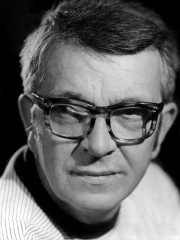
10. Zoltán Fábri (1917 - 1994)
With an HPI of 61.17, Zoltán Fábri is the 10th most famous Hungarian Film Director. His biography has been translated into 28 different languages.
Zoltán Fábri (15 October 1917 – 23 August 1994) was a Hungarian film director and screenwriter. His films The Boys of Paul Street (1969) and Hungarians (1978) were nominated for the Academy Award for Best Foreign Language Film. His 1965 film Twenty Hours shared the Grand Prix with War and Peace at the 4th Moscow International Film Festival. His 1969 film The Toth Family was entered into the 7th Moscow International Film Festival. His 1975 film 141 Minutes from the Unfinished Sentence was entered into the 9th Moscow International Film Festival, where he won a Special Prize for Directing.
People
Pantheon has 30 people classified as Hungarian film directors born between 1873 and 1977. Of these 30, 10 (33.33%) of them are still alive today. The most famous living Hungarian film directors include István Szabó, Márta Mészáros, and Ildikó Enyedi. The most famous deceased Hungarian film directors include Michael Curtiz, Miklós Jancsó, and Béla Tarr.
Living Hungarian Film Directors
Go to all RankingsIstván Szabó
1938 - Present
HPI: 68.11
Márta Mészáros
1931 - Present
HPI: 63.67
Ildikó Enyedi
1955 - Present
HPI: 60.20
Lajos Koltai
1946 - Present
HPI: 56.46
Ágnes Hranitzky
1945 - Present
HPI: 56.32
Gábor Csupó
1952 - Present
HPI: 52.42
László Nemes
1977 - Present
HPI: 52.32
Peter Medak
1937 - Present
HPI: 51.94
György Pálfi
1974 - Present
HPI: 47.20
Kornél Mundruczó
1975 - Present
HPI: 47.02
Deceased Hungarian Film Directors
Go to all RankingsMichael Curtiz
1886 - 1962
HPI: 70.06
Miklós Jancsó
1921 - 2014
HPI: 66.90
Béla Tarr
1955 - 2026
HPI: 65.51
Adolph Zukor
1873 - 1976
HPI: 64.49
Ladislao Vajda
1906 - 1965
HPI: 61.92
Andre DeToth
1913 - 2002
HPI: 61.82
Ján Kadár
1918 - 1979
HPI: 61.35
Zoltán Fábri
1917 - 1994
HPI: 61.17
László Benedek
1905 - 1992
HPI: 60.94
Charles Vidor
1900 - 1959
HPI: 60.09
Andrew Marton
1904 - 1992
HPI: 59.21
Ferenc Kósa
1937 - 2018
HPI: 58.04
Overlapping Lives
Which Film Directors were alive at the same time? This visualization shows the lifespans of the 20 most globally memorable Film Directors since 1700.

